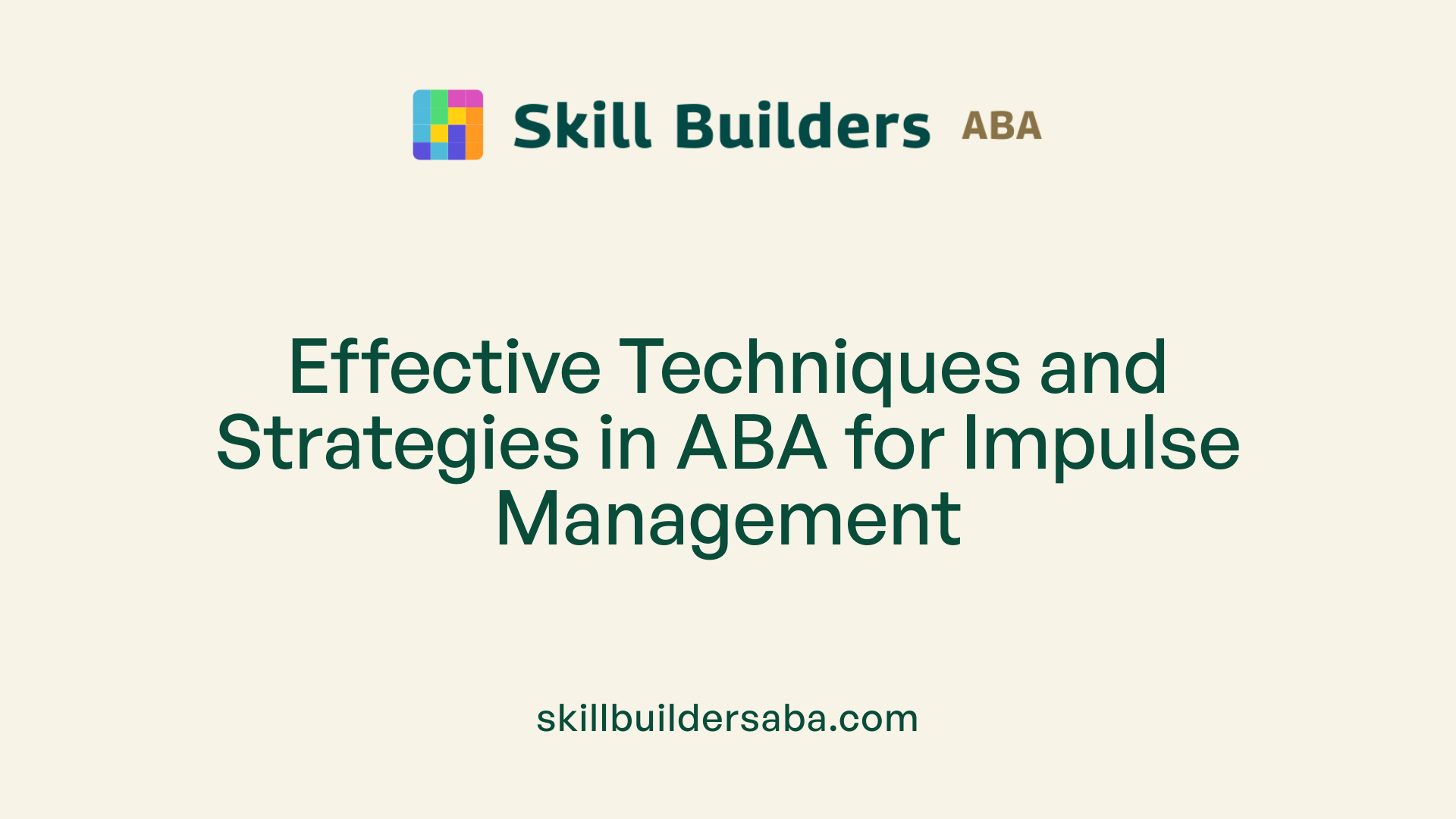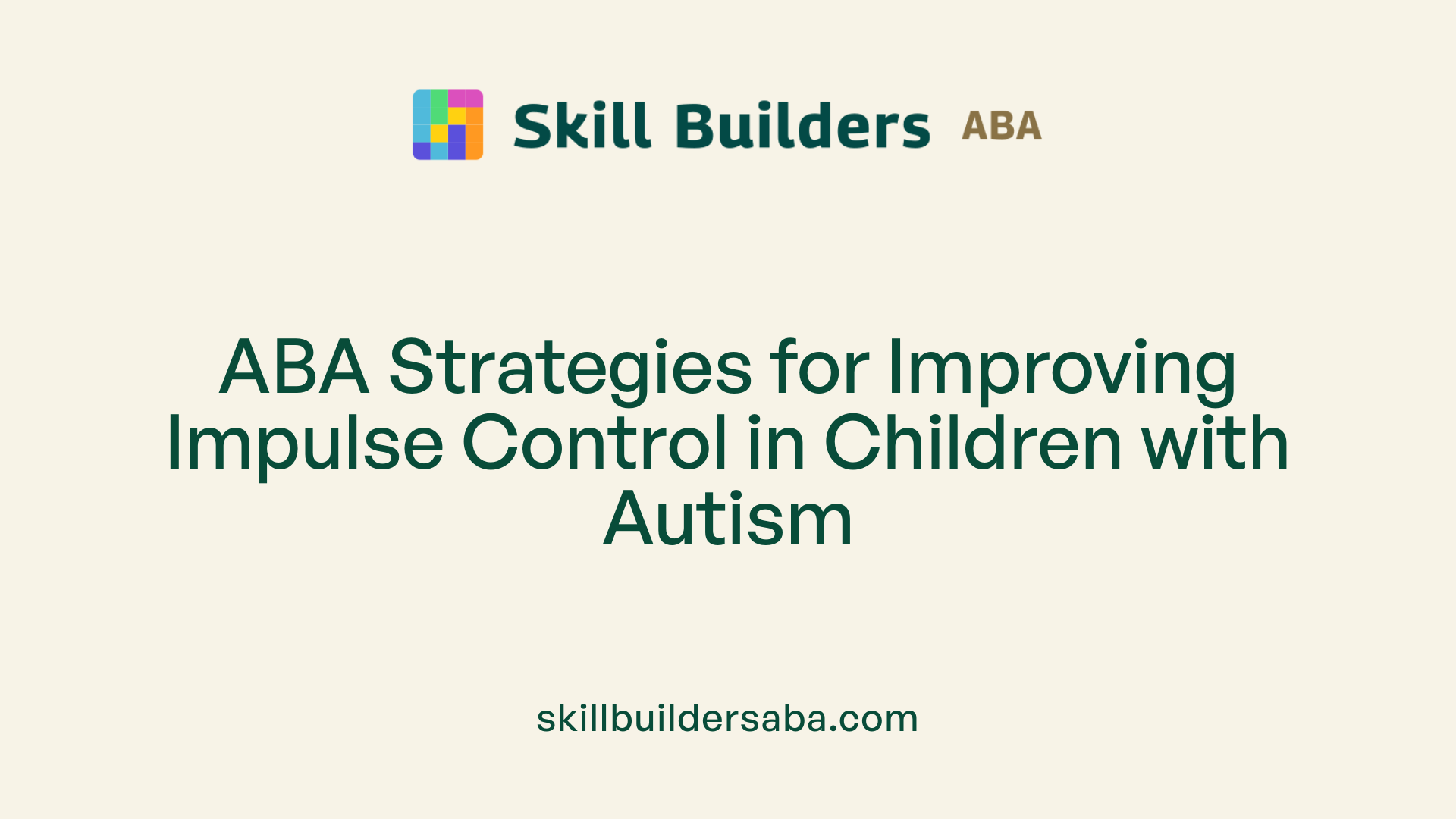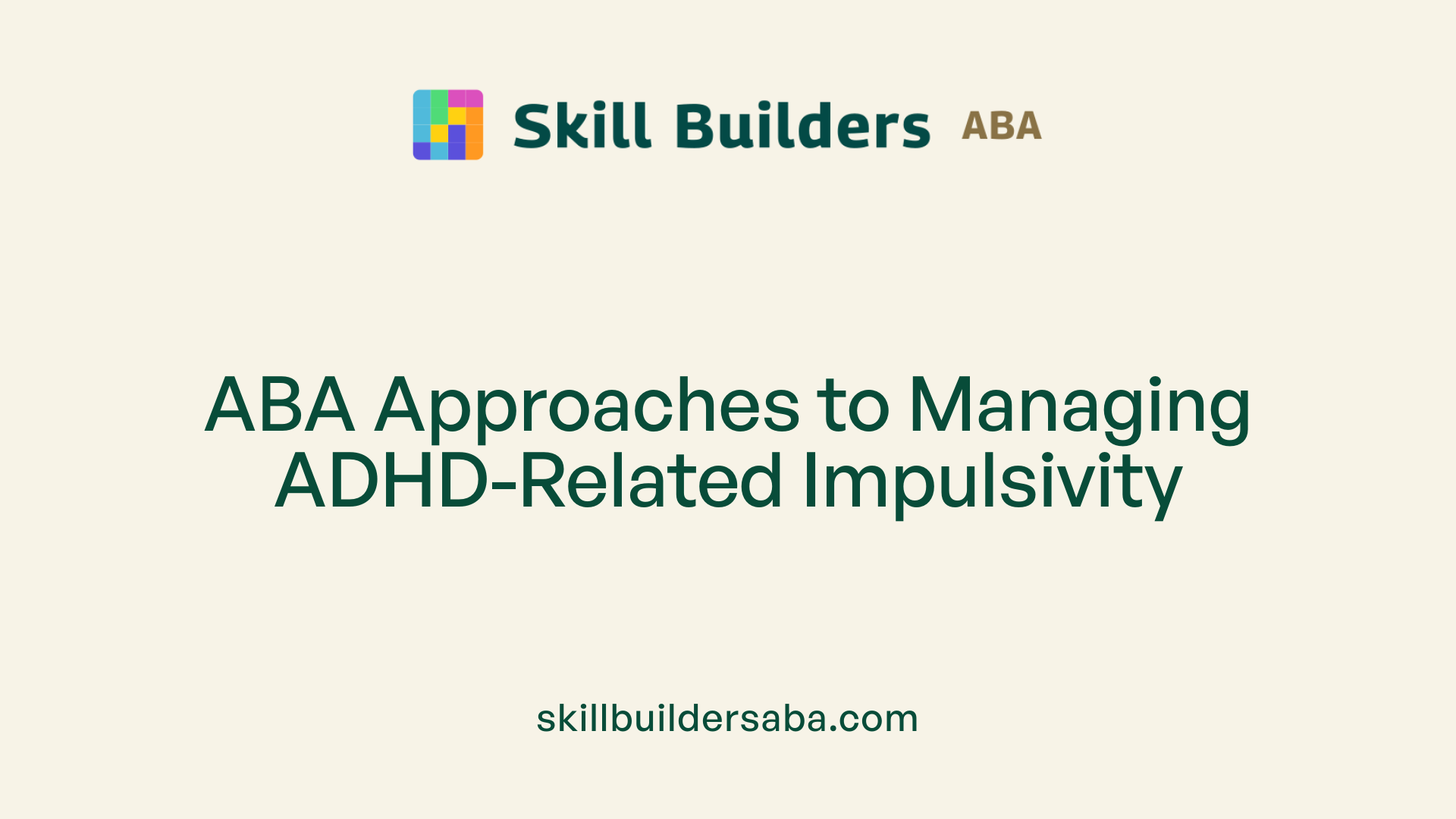
ABA approaches to reducing impulsive behaviors
Transforming Impulse Control Through Behavioral Science
Understanding ABA in the Context of Impulse Reduction
Applied Behavior Analysis (ABA) is a scientifically-supported approach that has effectively been used to manage and reduce impulsive behaviors, particularly in children with autism spectrum disorder (ASD) and attention-deficit/hyperactivity disorder (ADHD). Grounded in the principles of operant conditioning, ABA employs a systematic process of understanding environmental variables influencing behaviors and implementing targeted interventions. This article explores the key strategies, techniques, and best practices involved in ABA's approach to behavioral regulation, emphasizing how individualized programs can foster self-control and emotional regulation.
Core Principles and Foundations of ABA in Impulse Control

What are the fundamental concepts of ABA that support reducing impulsivity?
Applied Behavior Analysis (ABA) is rooted in understanding how behaviors are influenced by the environment. It focuses on the relationship between antecedents (what happens before a behavior), behaviors themselves, and consequences (what happens after). When it comes to impulsivity, ABA aims to modify environmental variables to promote better control over impulsive actions.
Through analyzing these behavior patterns, therapists can identify triggers—such as sensory stimuli or emotional states—that lead to impulsive responses. By adjusting these triggers or providing alternative, more appropriate responses, ABA helps children develop greater self-control.
Managing impulsivity involves teaching children to recognize their emotional and physical cues, which often precede impulsive actions. Techniques such as self-monitoring and emotional recognition are closely tied to the environmental analysis in ABA.
How does behavioral analysis use environmental factors to address impulsivity?
Behavioral analysis examines how different environmental variables—like sensory input, social context, and routine changes—affect impulsive behaviors. For example, a child might act impulsively when overwhelmed by noise or chaos.
ABA strategies work by altering these antecedents, such as providing a quiet space or visual schedules to reduce unexpected stimuli. Certain methods, like differential reinforcement, are used to strengthen alternative behaviors, such as asking for a break instead of acting out.
Breaking complex behaviors into smaller, manageable steps—known as task analysis—makes it easier for children to learn self-regulation over time.
Why is the scientific and empirical basis of ABA vital in impulse management?
ABA is regarded as a scientifically validated approach because it relies on rigorous experimentation, systematic data collection, and continuous evaluation. These aspects ensure that interventions are effective and tailored to each child.
Empirical evidence from research shows that ABA techniques can significantly decrease impulsive behaviors, whether in children with Autism Spectrum Disorder (ASD) or Attention Deficit Hyperactivity Disorder (ADHD). These techniques include positive reinforcement, response interruption, and functional communication training (FCT), all supported by scientific studies.
This data-driven approach provides a measurable way to track progress, make adjustments, and verify that the strategies lead to meaningful improvements.
What constitutes professional guidance and evidence-based practices in ABA for impulse reduction?
Professional guidance and evidence-based practices involve assessments by trained specialists like Board Certified Behavior Analysts (BCBAs) and Registered Behavior Technicians (RBTs). These professionals analyze individual behaviors through functional assessments to identify the purpose or function of impulsive actions.
Based on these assessments, they develop personalized treatment plans incorporating scientifically supported interventions. These may include extinction techniques, response blocking, and positive reinforcement to decrease harmful impulsive behaviors.
Constant monitoring and data collection are crucial, allowing for precise modifications to interventions. Ethical considerations and individual needs are prioritized to ensure safe and effective treatment.
Interventions also often include naturalistic teaching strategies, contingency management, and token economy systems, which reinforce desirable behaviors.
This comprehensive and tailored approach underscores the importance of responsible, empirically validated practices within ABA therapy.
| Aspect | Description | Related Techniques |
|---|---|---|
| Underlying Concepts | Behavior influenced by environment | Antecedents, consequences, contingencies |
| Behavioral Analysis | Understand triggers and responses | Task analysis, environmental modification |
| Scientific Support | Validated through research | Positive reinforcement, FCT, response blocking |
| Professional Guidance | Conducted by trained specialists | Functional assessments, individualized plans |
| Monitoring & Adjustment | Data collection to refine strategies | Ongoing analysis, data-based decisions |
This structure consolidates the core principles underpinning ABA’s effectiveness in helping children develop impulse control and improve their behavioral responses.
Techniques and Strategies in ABA for Managing Impulsivity

What strategies are used in ABA to manage impulsivity?
Applied Behavior Analysis (ABA) employs a variety of techniques aimed at helping children better regulate their impulses and emotional responses. Recognizing emotional states is fundamental, so children are taught to identify feelings like frustration, excitement, or anxiety, which can trigger impulsive behaviors.
Relaxation exercises, such as deep breathing and short pause activities, are integral parts of ABA interventions. These exercises help children develop calming strategies they can use when feeling overwhelmed. For example, a child might learn to take a few deep breaths before responding to a stressful situation.
Another effective method involves neutral redirection and ignoring inappropriate responses. When a child exhibits impulsive or disruptive behavior, therapists and parents are coached to avoid reinforcing the behavior by giving attention and instead redirect the child's focus to more appropriate actions or activities.
Positive reinforcement is frequently used to promote self-control. Reward systems like token economies are implemented, where children earn tokens or points for demonstrating calm, controlled behaviors or for successfully delaying gratification. Consistent praise and reinforcement of good behaviors increase the likelihood that these behaviors will recur.
Visual aids, routines, and antecedent logs create predictable environments that reduce uncertainty and impulsivity. Visual schedules help children understand what to expect during the day, minimizing impulsive reactions stemming from unpredictability.
Social skills training and role-playing provide safe practice opportunities for children to rehearse appropriate responses and develop better social understanding. This practice supports emotional regulation in real-life situations.
Environmental modifications are also crucial. Adjustments such as minimizing sensory overload or providing quiet spaces enable children to manage sensory triggers that might lead to impulsive outbursts.
Functional Communication Training (FCT) teaches children alternative ways to express frustrations, needs, or discomforts without resorting to impulsive or disruptive behaviors. Through FCT, children learn to request a break, use gestures, or say specific words instead of acting out.
Lastly, self-management techniques like goal-setting and self-monitoring empower children to take control of their behaviors. They learn to track their responses, recognize their progress, and implement coping strategies independently.
Overall, these core ABA strategies work together to build self-regulation skills necessary for managing impulsivity, especially in social contexts. Regular collaboration with therapists, educators, and parents ensures these techniques are effectively integrated into daily routines, fostering sustained behavioral improvements.
Application of Differential Reinforcement and Behavior Management Techniques

How is differential reinforcement applied in ABA to reduce impulsivity?
Differential reinforcement is a cornerstone strategy in ABA used to decrease impulsive behaviors by promoting more desirable responses. When applied, this method involves systematically reinforcing behaviors that are appropriate and controlled while ignoring or withholding reinforcement for impulsive or maladaptive actions.
For example, a child who typically acts out impulsively might be encouraged to use a calm voice or raise their hand to speak. When the child successfully employs these more acceptable behaviors, caregivers and therapists provide positive reinforcement, such as praise or tokens.
Various types of differential reinforcement are used based on the behavior targeted:
| Type | Description | How it Helps Reduce Impulsivity |
|---|---|---|
| Differential Reinforcement of Incompatible Behaviors (DRI) | Reinforces behaviors that are incompatible with impulsive actions, such as sitting quietly or using words instead of physical outbursts. | Prevents impulsive responses by strengthening alternative behaviors that cannot happen simultaneously. |
| Differential Reinforcement of Alternative Behaviors (DRA) | Rewards positive behaviors that serve as alternatives to impulsive actions, like asking for a break instead of yelling. | Encourages replacement behaviors that are socially acceptable and more controlled. |
| Differential Reinforcement of Other Behavior (DRO) | Reinforces periods during which the impulsive behavior does not occur. | Increases the length of calm, controlled intervals, thereby reducing impulsivity over time. |
Implementation involves consistent monitoring and immediate reinforcement following desired behaviors. Over repetitions, individuals learn to favor self-control and appropriate responses, leading to a noticeable decrease in impulsive behaviors.
Breaking down complex behaviors into manageable parts—known as task analysis—complements differential reinforcement by making skills easier to teach and learn. For instance, teaching a child to pause and breathe before acting can be segmented into step-by-step procedures, which are then reinforced at each stage.
In addition to reinforcement, ABA employs techniques like response interruption and response blocking. These strategies involve redirecting or physically stopping impulsive behaviors to interrupt them in real-time. For example, if a child begins to shout impulsively, a therapist might gently block the behavior and encourage a calming response.
Behavioral modeling and role-playing exercises are also valuable. Children observe and practice appropriate responses in simulated settings, which boosts their confidence and ability to handle triggering situations effectively.
All these strategies combined form a comprehensive approach to help individuals with autism develop better impulse control. They are tailored to each child's specific needs and are most effective when consistently applied across environments, including home, school, and therapy sessions.
ABA Interventions for Children with Autism

What ABA interventions are effective for impulse control in children with autism?
Applied Behavior Analysis (ABA) offers a variety of techniques to help children with autism improve impulse control. These interventions are rooted in understanding behavior through systematic analysis and applying evidence-based strategies.
One fundamental approach involves positive reinforcement systems, like token economies, where children earn tokens or praise for exhibiting controlled behaviors. Reinforcing calm and adaptive responses encourages children to repeat these behaviors, gradually reducing impulsive actions.
Functional Behavior Assessment (FBA) plays a crucial role in personalizing interventions. By identifying specific triggers—such as sensory overload or frustration—therapists and caregivers can tailor strategies to address those triggers directly. This might include environmental modifications or teaching alternative, more appropriate responses.
Teaching skills such as waiting, following instructions, and emotional regulation are central to ABA. For example, children learn to pause before acting, employ deep breathing techniques, or use visual supports like timers to manage their impulses effectively.
Self-management strategies are also emphasized. Techniques like using timers for task completion, visual cues for routines, and mindfulness exercises help children develop internal control over their impulses. These tools foster independence and self-awareness, supporting emotional regulation during challenging moments.
Caregiver training ensures consistent application of these methods across settings. When parents and teachers are actively involved and follow structured plans, children's progress accelerates. Consistency in reinforcement and behavior management is vital for sustainable improvements.
Additionally, interventions such as teaching patience through structured waiting tasks, implementing response interruption procedures, and modeling appropriate responses in role-play scenarios contribute to better impulse control. These methods cultivate self-regulation skills that are crucial for social and adaptive functioning.
In summary, a combination of tailored assessments, positive reinforcement, skill-building, environmental supports, and caregiver involvement leads to effective management of impulsive behaviors in children with autism, enhancing their overall adaptive and social skills.
Addressing Impulsivity in ADHD Through ABA

How does ABA address impulsive behaviors associated with attention-deficit/hyperactivity disorder (ADHD)?
ABA, or Applied Behavior Analysis, offers effective strategies to help children with ADHD manage impulsive behaviors. By analyzing what triggers impulsivity and understanding how certain consequences reinforce these behaviors, ABA interventions aim to promote self-control and appropriate responses.
One fundamental approach involves positive reinforcement, where desirable behaviors—like waiting patiently or using words instead of impulses—are rewarded. This encourages children to repeat those responses in daily situations. ABA technicians often conduct behavioral assessments to pinpoint specific triggers for impulsivity, such as sensory overload or unstructured environments, and then develop personalized plans.
Self-management training is a core element of ABA. Children learn techniques like goal-setting, self-monitoring, and using visual cues to recognize their emotional states and impulses. For example, visual timers or social stories can help children understand when to pause or use coping strategies.
Structured routines and visual supports are also vital. Consistent schedules and visual aids like charts and pictures reduce surprises and uncertainties, which may trigger impulsive reactions. These tools help children anticipate upcoming activities and understand expected behaviors.
In addition to routine modifications, ABA employs behavioral interventions such as token economies, where children earn tokens for appropriate behaviors which can be exchanged for rewards. Response cost, another technique, involves removing tokens or privileges when impulsive or inappropriate behaviors occur, encouraging better self-control.
Reinforcing alternative behaviors is crucial. Instead of impulsively shouting or acting out, children are taught and encouraged to use words or gestures to express needs. Differential reinforcement of alternative behaviors (DRA) involves rewarding these positive alternatives while ignoring or gently redirecting impulsive acts.
Furthermore, ABA strategies like response cost and differential reinforcement can be combined to effectively decrease impulsivity. Response cost removes reinforcement for undesirable behaviors, while DRA strengthens desirable responses.
Through consistent application of these techniques, ABA fosters improved impulse regulation, better social interactions, and enhanced daily functioning for children with ADHD. Tailoring interventions to each child's unique needs and involving caregivers in the process helps ensure the greatest success.
| Strategy | Description | Purpose |
|---|---|---|
| Behavioral analysis | Identifying triggers and consequences | Targeted intervention development |
| Positive reinforcement | Reward for desirable behaviors | Increase self-control |
| Self-management training | Teaching goal-setting and self-monitoring | Improve impulse awareness |
| Structured routines and visual supports | Using schedules and visual cues | Reduce impulsive triggers |
| Token economies | Earning tokens for appropriate behaviors | Reinforce positive responses |
| Response cost | Removing tokens or privileges | Discourage impulsive acts |
| Differential reinforcement | Reinforcing alternative behaviors | Promote adaptive responses |
Ultimately, ABA's comprehensive approach addresses both the triggers and the behaviors themselves, equipping children with strategies to better control impulses across various settings.
The Role of Evidence-Based Practice and Ethical Considerations in ABA
What constitutes professional guidance and evidence-based practices in ABA for impulse reduction?
In ABA therapy, professional guidance involves the work of trained and certified practitioners such as Board Certified Behavior Analysts (BCBAs) and Registered Behavior Technicians (RBTs). These experts conduct detailed assessments to identify the functions of impulsive behaviors and design tailored intervention plans.
Effective interventions are rooted in scientific research and include techniques like extinction procedures, response blocking, differential reinforcement, and functional communication training (FCT). These strategies aim to diminish impulsive actions that may be harmful or disruptive.
Data collection is a cornerstone of ABA, where ongoing progress monitoring helps therapists assess the effectiveness of interventions. This systematic approach allows for timely adjustments, ensuring each child’s safety and well-being.
Interventions are individualized, taking into account the child’s unique needs, environment, and underlying triggers for impulsivity. By employing evidence-based methods such as naturalistic teaching, contingency management, and token economies, therapists promote more appropriate behaviors and emotional regulation.
Furthermore, ethical practice involves adhering to the Behavior Analyst Certification Board (BACB) guidelines and ethical standards. This includes ensuring interventions are respectful, maintaining confidentiality, and involving families in treatment planning.
Integrating the latest neuroscience and genetics research holds promise for future advancements in understanding and managing impulsivity. This integration can lead to more precise, personalized interventions that align with the biological underpinnings of each individual’s behaviors.
In summary, the comprehensive approach of evidence-based guidance and ethical practice in ABA ensures safe, effective, and respectful treatment, ultimately helping children with autism and related conditions better manage impulsive behaviors and improve their adaptive functioning.
Future Directions and Emerging Trends in ABA for Impulse Control
How is the integration of neuroscience and genetics influencing ABA approaches?
Emerging research is increasingly focusing on how neuroscience and genetics can inform Applied Behavior Analysis (ABA) strategies. By understanding the neurological underpinnings of impulsivity and emotional regulation in children with ASD and ADHD, therapists can tailor interventions more precisely. For example, insights into neural pathways involved in impulse control may lead to developmentally targeted techniques, enhancing the effectiveness of behavioral therapies. This integration not only deepens our understanding of individual differences but also paves the way for personalized treatment plans that consider genetic predispositions.
What does current research say about addressing higher-order behaviors like insistence on sameness?
Higher-order behaviors such as insistence on sameness and circumscribed interests remain challenging for behavioral interventions. Recent studies highlight the importance of modifying intervention strategies to encourage behavioral flexibility. Approaches like Differential Reinforcement of Variability (DRV) and contingency reinforcement are gaining traction. These methods focus on rewarding behaviors that promote adaptability and spontaneity, aiming to reduce the rigidity often observed in ASD. While evidence supports these strategies for lower-order behaviors, ongoing research aims to establish robust, evidence-based practices applicable to more complex, higher-order behaviors.
Why are early intervention and parental involvement critical in ABA therapy?
Early intervention remains a cornerstone of effective ABA therapy, especially for managing impulsivity and emotional dysregulation. Initiating therapy during crucial developmental windows can significantly improve long-term outcomes. Parental involvement enhances this effect by ensuring consistency and reinforcement across environments like home and school. Training parents to implement ABA techniques allows for ongoing support outside clinical sessions, fostering generalization of new skills. This collaborative approach not only boosts adherence but also empowers families to contribute actively to their child's progress.
How does addressing comorbid conditions improve ABA outcomes?
Children with ASD often face comorbid conditions such as anxiety, mood disorders, OCD, or ADHD, which can exacerbate impulsivity and emotional challenges. Effectively managing these conditions alongside ABA interventions can lead to better behavioral outcomes. For instance, incorporating anxiety reduction techniques or response prevention strategies can decrease emotional outbursts and improve impulse control. Addressing these comorbidities through tailored ABA strategies ensures a more comprehensive treatment plan, promoting overall well-being and adaptive functioning.
What are the promising directions for developing new evidence-based practices in ABA?
Researchers are exploring innovative ABA methodologies to tackle complex behaviors more effectively. These include integrating technology-based tools like apps and wearable devices for real-time monitoring, designing multidisciplinary interventions combining ABA with cognitive-behavioral therapies, and emphasizing cultural and individual adaptations. Emphasis is also placed on developing strategies that address higher-order behaviors and emotional regulation specifically. Continued clinical trials and longitudinal studies are necessary to establish these approaches as evidence-based, ensuring they are both effective and generalizable across diverse populations.
| Aspect | Current Focus | Future Developments | Details |
|---|---|---|---|
| Neuroscience & Genetics | Understanding neural pathways | Personalized interventions | Tailoring ABA based on genetic profiles and brain function |
| Higher-Order Behaviors | Addressing insistence on sameness | Behavioral flexibility strategies | Reinforcement techniques like DRV |
| Early Intervention | Starting early for best outcomes | Integrating parental training | Enhancing generalization across settings |
| Comorbid Conditions | Managing co-occurring disorders | Combined behavioral and medical strategies | Unified approaches for better emotional regulation |
| New Practices | Applying technology & innovations | Developing robust, evidence-based methods | Use of apps, wearable devices, and multidisciplinary approaches |
Advances in understanding underlying biological factors, coupled with innovative behavioral strategies, promise a future where ABA can be more precisely tailored to individual needs. This will potentially improve impulse control and emotional regulation for children with ASD and ADHD, leading to improved quality of life.
Enhancing Outcomes with ABA's Science-Based Approach
ABA provides a structured, evidence-based framework for reducing impulsivity, promoting adaptive behaviors, and improving overall quality of life. As research continues to evolve, integrating neuroscience, early intervention, and family involvement will further enhance its effectiveness. Practitioners committed to ethical standards and continuous data collection are essential to advancing the field and supporting individuals with impulse control challenges.
References
- 40 Activities to improve impulse control in Autism
- Can ABA Help With Impulse Control? | Childwise
- ABA Therapy for ADHD: Effective Strategies for Kids
- From Meltdowns to Calm:ABA Therapy Strategies for Managing ...
- Autism and Impulse Control: What Caregivers Should Know
- ABA therapy for ADHD Treatment: Techniques & Examples - Mentalyc
- Evidence-Based Behavioral Interventions for Repetitive Behaviors in ...
Learn More and Take the First Step
If you’d like a clearer understanding of how our programs work, begin by exploring our site at your own pace. And when you're ready for a conversation about next steps, you can get in touch with a coordinator.
Reach Out Today
Learn more about how we can support your child’s growth and development. Contact us to discuss our services and availability in your area.
.svg)